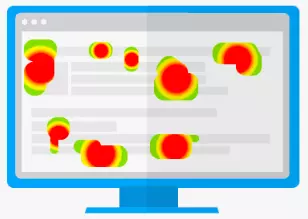Heat Maps
Definition
A heat map in marketing is a visual representation of data that shows the areas of a webpage or email that receive the most engagement or clicks from users, helping to identify patterns and optimise marketing efforts.
Description
Increasing engagement from the users is the primary intent of marketers. A heat map in marketing visually represents data to show the areas of a webpage or email that receive the most engagement or clicks from users, using colour to indicate the intensity or density of user activity.

Heat maps help marketers identify patterns in user behaviour, such as where users tend to click the most, and optimise their marketing efforts accordingly to improve conversions and user experience. Heat maps can also be used to track the performance of various marketing campaigns and make data-driven decisions about future marketing strategies.
Importance of Heat Map in Marketing
Heat maps are an essential tool in marketing for several reasons:
- Identifying hotspots: Heat maps help identify the areas on a webpage or email that receive the most engagement or clicks, indicating which areas are most effective in grabbing the user’s attention. This can help marketers optimise their content and design to better engage their audience.
- Understanding user behaviour: Heat maps help marketers understand how users interact with their content, such as where they focus their attention or navigate the page. This information can be used to improve user experience and drive conversions.
- A/B testing: Heat maps can be used to compare the performance of different versions of a webpage or email, allowing marketers to test various design and content elements and make data-driven decisions about what works best.
- Optimization: Heat maps can be used to optimise marketing campaigns, helping to increase engagement and conversions by focusing on the areas of a webpage or email that receive the most user activity.
How to use heat maps for SEO strategy?
Heat maps can be a valuable tool for SEO strategy in the following ways:
- Content optimization: Heat maps can help identify the areas of a webpage that receive the most clicks or engagement from users, indicating which content is most relevant and valuable to them. This information can be used to optimise content to improve its SEO performance.
- User experience optimization: Heat maps can help identify webpage areas that do not receive as much engagement or clicks, indicating potential user experience issues. This information can be used to optimise the user experience of a webpage, which can improve its search engine ranking.
- Identifying keyword opportunities: Heat maps can help identify keywords most relevant to users by analysing the areas of a webpage that receive the most clicks or engagement. This information can be used to identify new keyword opportunities and optimise content for those keywords.
- Tracking user behaviour: Heat maps can help track how users interact with a web page over time, providing insights into user behaviour and preferences. This information can be used to continuously optimise content and user experience for better SEO performance.
Future of Heat Map in digital marketing
The future of heat maps in digital marketing will likely involve more advanced and sophisticated technology, such as artificial intelligence and machine learning. This will allow for an even more precise and accurate analysis of user behaviour and engagement, providing deeper insights into user preferences and patterns. Additionally, integrating heat maps with other tools and technologies, such as predictive analytics and personalization engines, will enable marketers to deliver even more targeted and personalised experiences to their users. As digital marketing continues to evolve and become more data-driven, heat maps will be an essential tool for analysing user behaviour and optimising marketing strategies for better results.
Example
Flipkart uses heat maps to track user engagement on its website, analysing which areas of the site receive the most clicks and attention. This information is used to optimise the user experience and drive conversions. Heat maps are also used to analyse the performance of marketing campaigns and promotional offers, helping to make data-driven decisions about future marketing strategies. Using heat maps, Flipkart can gain valuable insights into user behaviour and optimise its marketing efforts for better results.
FAQ
What is a heat map in marketing?
A heat map in marketing is a visual representation of data that shows the areas of a webpage or email that receive the most engagement or clicks from users, using colour to indicate the intensity or density of user activity.
How is a heat map used in marketing?
Heat maps are used in marketing to analyse user behaviour, optimise content and design, and improve user experience. They help identify the areas of a webpage or email that receive the most clicks or engagement and can be used to test and optimise different marketing strategies.
What are the benefits of using a heat map in marketing?
The benefits of using a heat map in marketing include identifying hotspots on a webpage or email, understanding user behaviour, A/B testing, and optimization. Heat maps can provide valuable insights into user behaviour and help marketers make data-driven decisions about their marketing strategies.
What are some tools that can be used to create a heat map?
Several tools can be used to create a heat map, such as Crazy Egg, Hotjar, and Mouseflow. These tools use tracking and analytics to generate heat maps that show user engagement and behaviour on a webpage or email.
How can heat maps be used for SEO strategy?
Heat maps can be used for SEO strategy by identifying webpage areas that receive the most engagement or clicks, optimising content for keywords, and improving user experience. Heat maps can also track user behaviour over time, providing insights into user preferences and enabling continuous optimization for better SEO performance.





We would love to have your opinion.